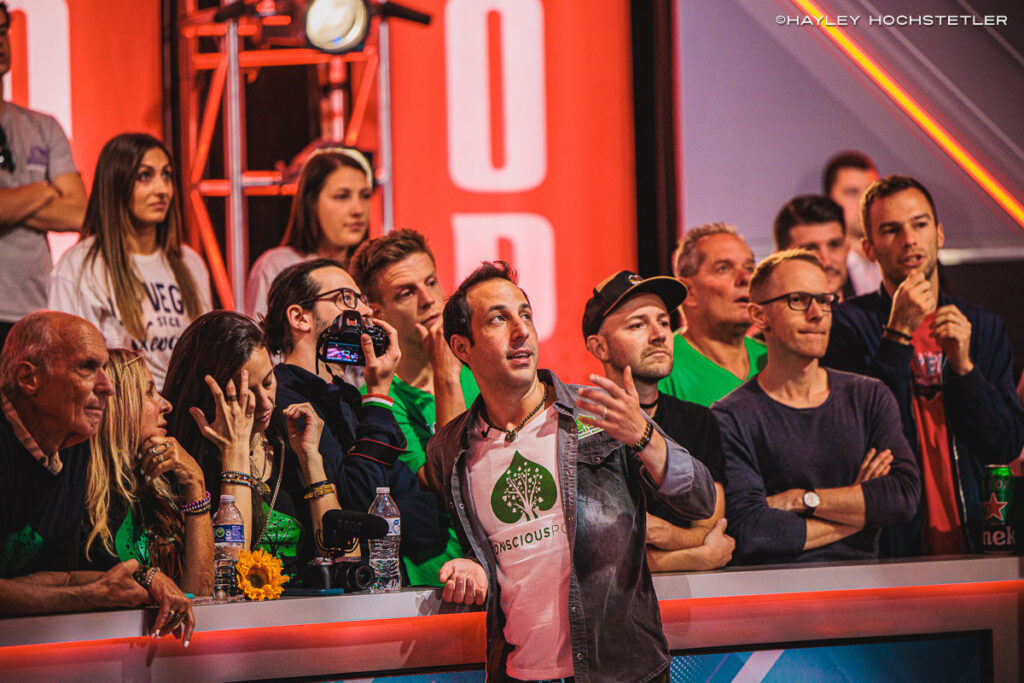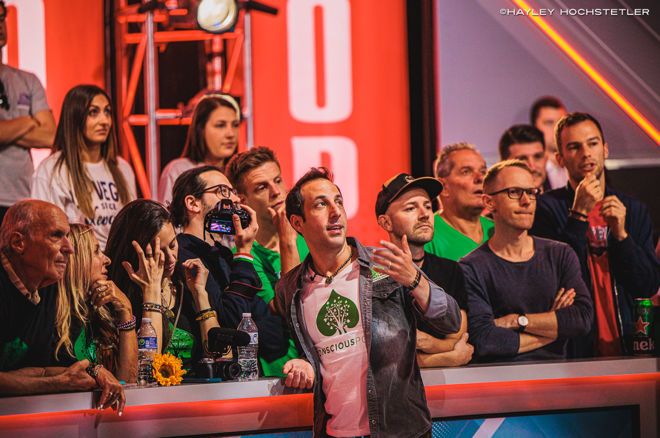
With 149 remaining in the 2023 World Series of Poker (WSOP) Main Event, the 16-year-old inside me watched as his poker dream unfolded in real-time. It was surreal, and before the day began, I vowed that no matter what happened, I was going to do my best to take it all in and enjoy the ride.
Before we get into Day 6 action, check out the past articles in this series:
I tried to center myself in the morning, beginning with my meditation, followed by a workout and a quick online check-in to receive a wonderful amount of positivity from many of you. As I sipped my morning brew, I pulled up my table draw and scanned the players, looking at our relative stack sizes to prepare my strategy.
By now I expected the competition to be competent; luck only takes one so far. Before I left my room, I let go of the plan. Experience has taught me the best strategy is to be fully present and play in flow, attuned to what is happening at that specific moment in time.
I returned with 3,600,000 in chips and the blinds at 40,000/80,000 with an 80,000 big blind ante (45 big blinds). But the truth is, I barely made it there.
Surviving Day 5… Barely
At the end of Day 5, with the blinds still at 30,000/60,000, and my stack at a healthy 5,150,000 (86 big blinds), the under-the-gun player opened to 125,000 and a Russian pro in second position put in a three-Bet to 375,000. I look down at the A♥K♥ in the small blind and reluctantly four-Bet to 1,200,000.
I say reluctantly because I felt like I had three bad options. Folding would have been weak, especially when my hand is suited. Calling was precarious as it would force me to play a deep-stacked, multi-way pot out of position when I’m unlikely to hit and have no idea where I’m at. The fact both players were in early position reduced the relative strength of my hand. Had this been a late-position open vs. button three-bet, I’d have been much happier to put in a reraise.
Although I didn’t love it, I still reasoned a four-bet was best. I could have the best hand, and if not, fold out some better ones, like 9x9x–JxJx. Being out of position and raising into two strong ranges, I opted for a larger sizing, just as I would if I were bluffing.
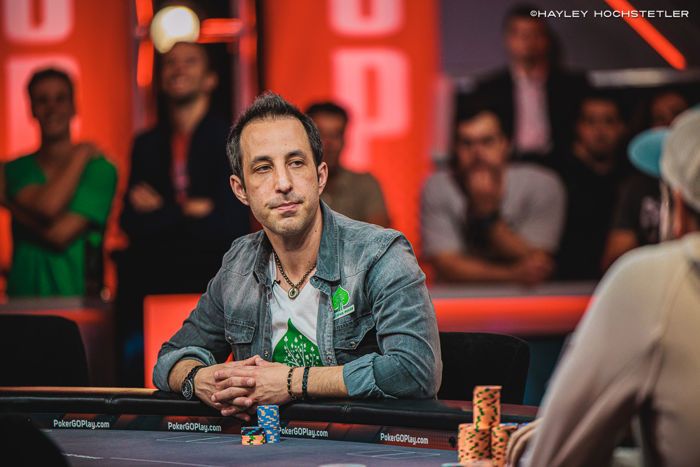
Under the gun immediately got out of the way, and rightly so. He’s only continuing with kings and aces there. The Russian went into the tank.
“Do you cover me?” he asked, cutting out his chips. I did, but just barely. I was more than happy for him to fold at this point. Picking up 650,000 preflop was plenty. And then I heard those two dreaded words, “All-in.”
I asked for an exact count, which was 4,850,000. The pot was roughly 6.3 million and it was another 3.6 million to me. I was getting 2.75:1 and needed roughly 35% equity to justify calling. That priced me in versus kings! If it were a cash game, I’d have no problem calling it off. The fact that some people shove AxKx and QxQx served to further increase my odds.
But this wasn’t a cash game, and my direct equity wasn’t the only thing to consider. I thought over a variety of other factors, such as how many chips I’d have left if I folded and how I could navigate with that stack. I then compared that with what it would mean if I called and won versus if I called and lost.
“I thought about how I’d feel if I called and he showed me aces as opposed to getting shown ace-king. I couldn’t forgive myself for the former, knowing I put in my entire big stack drawing nearly dead.”
I sat for several minutes, the longest of any decision the entire day. These spots are a challenge because it’s hard to identify the level of my opponent, how they perceive my range, and how light they are willing to shove.
Thoughts raced through my head: “What if he doesn’t believe me, and rockets in AxKx offsuit? I could be on a freeroll for a 10,000,000 chip stack!”
I thought about how I’d feel if I called and he showed me aces as opposed to getting shown ace-king. I couldn’t forgive myself for the former, knowing I put in my entire big stack drawing nearly dead, whereas the alternative of having a slight freeroll wasn’t worth that much. Rolling the dice with a potential flip didn’t sound appealing either. Once again, I found myself with two choices, neither of them great.
I decided preserving my playable stack was a better option than risking it all. I had navigated my way through several days by playing my “small ball” style and sticking to my game plan. It had worked so far. Perhaps I should trust the process.
And so, I let it go. It’s been said that one play can change the entire direction of your tournament. Sometimes it’s for the better, or as I would later learn, for the worse. After I folded, he revealed he had aces. I felt destined for a deep run and slept well that night.
Check out Alec Torelli’s strategy articles on PokerNews here!
Big Hand on Day 6
Day 6 was a rollercoaster, but fortunately for me, it was mostly one direction. I worked my stack up to 7 million with no showdowns, then busted a player blind-versus-blind when my Qx9x outdrew Ax8x. I was then up to 8,550,000 with 100 players left.
With the blinds at 50,000/100,000 and a 100,000 big blind ante, the under-the-gun player opened to 200K, and the button called. I looked down at the A♥A♠ in the big blind, and put in three-Bet to 700,000.
I’d normally go bigger here, but the rather awkward 3.5 million effective stacks didn’t quite allow it. In tournament poker, I adjust my raise and bet sizing depending on the relative stack sizes of the players involved.
It’s a very nuanced approach, and the finesse it requires every hand is what makes tournament poker so captivating. It’s a never-ending chase for perfection, which one can never quite seem to attain.
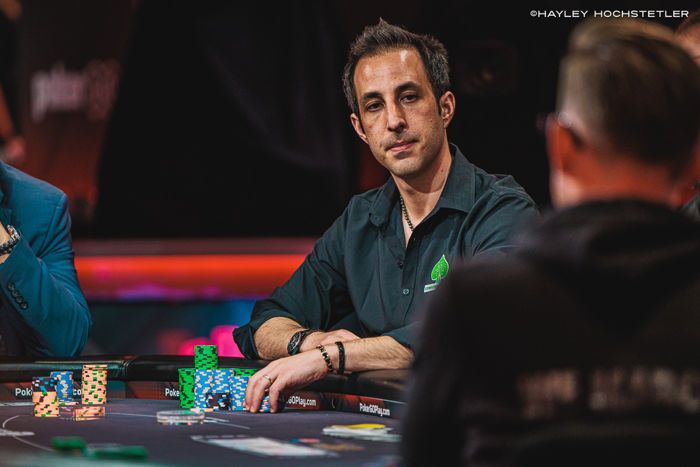
Both players called and the flop came down 9♥7♦5♥. Covering the backdoor flush draw, I opted for a check. Given the strong preflop action, I felt a bet into two players on this specific board looked incredibly strong. Besides, if someone had an overpair, they’d bet it for me.
Just the opposite happens. It checked around.
The turn was the 10♦, bringing a second flush draw. No more slow playing. I led 900,000 into 2.1 million. After some deliberation, the UTG original raiser shoved for 2.7 million total. The button quickly got out of the way, and it was back on me.
Other than top set or a very occasional 10♠9♠ (only 2 combos of that; 5 combos total), I couldn’t see how I was behind. Better hands like sets and two pairs almost certainly would have bet the flop. Perhaps he turned a big draw, top pair, or slow-played jacks or queens. Against that range, I’m doing just fine, and I called it off.
When the cards were turned up, I was shown the bad news. Three tens. The river bricked, and just like that I undid six hours of hard work and descended to 4.9 million.
As I had done countless times over the past six days, I closed my eyes to reset myself, visualizing how I intended to play going forward and finished with seeing myself at the final table.
I watched the thoughts but tried my best not to cling to them. “If only that ten didn’t come, I’d have busted him, or at least won a big pot.” It’s never easy, but I don’t stop until I can let it go.
“Perhaps it’s delusion or a coping mechanism, but I convinced myself I lost the hand to test my resolve and ability to recover. ‘It’ll be a great story someday,’ I told myself.”
I do my best to avoid being results-oriented, but it helps to know the outcome would have been the same even if I chose to bet the flop – he’d have called, and I would have shoved the turn into him.
Perhaps it’s delusion or a coping mechanism, but I convinced myself I lost the hand to test my resolve and ability to recover. “It’ll be a great story someday,” I told myself.
I’m surprisingly pleased that I’m soon filled with calmness. The months of preparation, doing this exercise every day in various settings, from my morning meditations to my afternoon runs, are starting to pay off.
I glided through the next level, keeping my focus on maintaining elevated feelings of joy, excitement, and gratitude. I wish I could say I always play from this state, but I don’t. It’s a continual battle and never-ending work in progress to get there, but it’s sweet when I do.
The losses I incurred didn’t seem to stick like olive oil mixed with vinegar. I shrugged them off, reset quickly, and continued to drive. Maybe it was my state, or that I had firmly convinced (deluded?) myself that I was going to recover and that something good was coming; I could feel it. I navigated up to 5.85 million, and then it happened.
Setting Up the Chip Leader
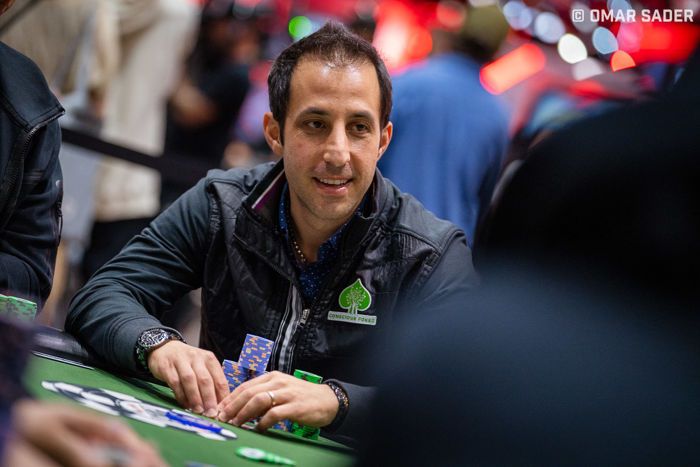
UTG+1 brought it in for 200,000 and the chip leader called next to him. I defended in the big blind with 3x3x, and we went three ways to the flop.
It was a dream — J♦5♣3♦. Both myself and the original raiser checked, and the chip leader bet 175,000. I had been studying him all day and observed his changing mood. He had just folded the river in a big four-bet pot, and I could sense he was eager to recover the loss.
I asked myself, “What would make my hand look the weakest?”
I put in a large, fishy raise to 700,000, hoping to represent a draw. He’ll reason my top pair hands wouldn’t continue this way, opting for a check-call instead, and therefore put me on air. Without much hesitation, he called.
The turn came an offsuit 8x, the perfect card for me to continue. Another big bet and he’ll read me for an improved semi-bluff, a 7x6x type of hand that turned more equity.
I fired 1.6 million, a huge polarizing bet. I was representing two pair at minimum, otherwise, I have nothing. I figured he would read it as there aren’t many two-pair combos I could have, and wouldn’t believe me.
Almost without thought, he jammed over the top. I called immediately and was shown the good news. He has pocket fives. It worked! I got him to put it all in with an underpair!
I was one card away from having a massive stack with 87 players remaining. I stood up, unable to contain the emotion. The cameras zoom in as they happen to catch the moment live. It bricked and I chipped up to 11,800,000.
After that double-up, I couldn’t be stopped. I finished the day with 21,075,000, a top five stack with 49 remaining. I saw my lifelong poker dream of making the Main Event final table drawing ever so close.
But life doesn’t always give us what we expect. I found out soon enough that it was the peak of my run, and frankly, as one of my favorite songs’ laments, “It’s All Downhill From Here.”
Stay tuned for the next installment where I’ll break down the action from Day 7.
In the meantime, follow me on X and Instagram for daily poker updates and hand reviews.For more awesome poker content, including our free weekly newsletter, check out ConsciousPoker.com.
Also, This series is the teaser for a WSOP Tournament Masterclass course I’m releasing to help others excel in tournaments.
See the first module for free right here.
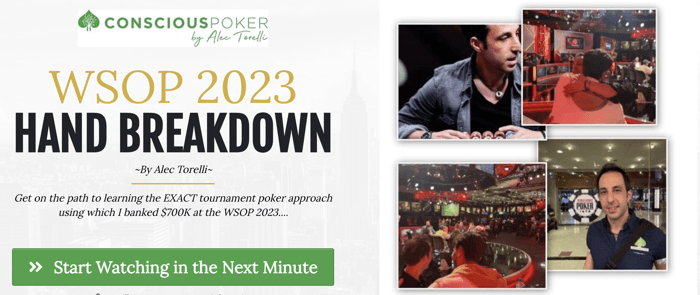
Alec Torelli has been playing high-stakes poker professionally since 2006. With over $2.2 million in tournament winnings and millions more in both live and online cash games, Alec is one of the most respected poker players in the industry today. He has been featured on ESPN, CBS Sports, Travel Channel, Fox Sports, Cigar Aficionado, PokerNews, and many more.
In 2015, Alec founded Conscious Poker to teach poker players how to improve their game, move up in limits, and achieve their poker goals. Since then, Alec has coached nearly a hundred players both in person and virtually, and thousands more have taken his programs to take their game to the next level.




